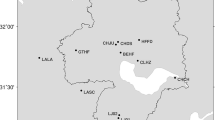Abstract
Based on the time series of GPS station coordinate in the intemational Earth reference frame (ITRF), we evaluate annual micro-behavior of strain field in Chinese mainland with the triangle method. The results show that the annual micro-behavior of strain field is divided into two parts by the north-south earthquake belt in the research region. The prevailing direction of compressive principal strain field is nearly consistent in the western region. From west to east, the direction varies from NS to NE. It is in accordance with the direction of the modern compressive principal strain field. This suggests that geologic deformation in western region was mainly caused by that India tectonic plate pushes the research region northward and the Siberia plate pushes it southward relatively. It is an inheritance of new tectonic motion. The prevailing direction of the compressive principal strain field does not exist in the eastern region. The annual biggest shear strain is different greatly in every grid-cell. The values varies from 4.13×10−8 to 7.0×10−10. By and large the annual biggest shear strain in the western region is bigger than that in the eastern region. And so is the variation between any two consecutive biggest annual shear strains in the same grid-cell. The annual surface dilatation show that in most grid-cells of the research region the surface dilatation is in compressibility, and the variation between any two consecutive annual surface dilatation in the same grid-cell is small.
Similar content being viewed by others
References
DING Guo-yu eds. 1991. Lithospheric Dynamics of China Explanatory Notes for the Altas of Lithospheric Dynamics of China [M], Beijing: Seismological Press, 158–159.
GU Guo-hua, SUN Han-rong, SUN Hui-juan, et al. 1998. Deduction of strain from GPS crustal deformation data in geodetic coordinate system [J]. Crustal Deformation and Earthquake, 18(3): 315–317 (in Chinese).
GU Guo-hua, SHEN Xu-hui, WANG min, et al. 2001. General characteristic crustal movement of the recent horizontal in Chinese mainland [J]. Acta Seismologica Sinica [J], 14(4): 384–393.
JIANG Fu and DAI Li-si 1989. Focal dislocation and seismogenic stress field [A]. In: MA Xing-yuan eds. Lithospheric Dynamics Atlas of China of 19 [C]. Beijing: China Cartographic Publishing House, 19 (in Chinese).
JING Shao-qun, WU Yun, QIAO Xue-jun, et al. 2005. GPS time-series and its response to M s=8.1 Kunlunshan earthquake [J]. Acta Seismologica Sinica, 18(4): 419–426.
LI Yan-xing, YANG Guo-hua, LI Zhi, et al. 2003, Movement and deformation of active tectonic blocks in Chinese mainland [J]. Science in China (Series D), 33(suppl), 65–81.
MA Zong-jin and DU Pin-ren. 1995. Problems on Recent Crustal Movement [M]. Beijing: Geologic Publishing House, 1–2 (in Chinese).
NIU Zhi-jun, MA Zong-jin, CHEN Xin-lian, et al. 2002. Crustal movement observation network of China [J]. Journal of Geodesy and Geodynamics, 22(3): 88–94 (in Chinese).
SHI Yao-lin. 2004. Summation and decomposition of principal stresses in the crust [J]. Acta Seismologica Sinica, 17(1): 114–118
WU Ji-cang, Conrad Teng, CHEN Yong-qi. 2003. Effects of triangle shape factor on precision of crustal deformation calculated [J]. Journal of Geodesy and Geodynamics, 23(3): 26–30 (in Chinese).
YANG Shao-min, WANG Qi, YOU Xin-zhao. 2005. Numerical analysis of contemporary horizontal tectonic deformation fields in China from GPS data [J]. Acta Seismologica Sinica, 27(2): 135–146.
ZENG Qiu-sheng, BIAN Zhao-yin, YE Cheng-zhi, et al. 1989. State of recent crustal stress. In: MA Xing-yuan eds. Lithospheric Dynamics Atlas of China of 20 [C]. Beijing: China Cartographic Publishing House, 20 (in Chinese).
China Seismological Bureau. 2001. Album of the Kunlun Pass west. M s=8.1 earthquake, China. SONG Rui-xiang eds. Beijing: Seismological Press, 1–13.
ZHOU Shuo-yu. 1994. Work hard to establish foundation science applied in the earthquake forecast-And talking about the present crustal movement dynamics [J]. Journal of seismology, 1(4): 12–14 (in Chinese).
ZHOU Shuo-yu. 1999. Crustal deformation advancing towards 21th century: A new impetus to continental dynamics and earthquake prediction [J]. Crustal Deformation and Earthquake, 19(1): 8–12.
Author information
Authors and Affiliations
Corresponding author
Additional information
Foundation item: National Natural Science Foundation of China (40074024).
About this article
Cite this article
Jing, Sq., Wang, Jw., Wu, Y. et al. Evaluation of micro-behavior of strain field in Chinese mainland with the GPS time series. Acta Seimol. Sin. 19, 514–521 (2006). https://doi.org/10.1007/s11589-006-0504-7
Received:
Accepted:
Issue Date:
DOI: https://doi.org/10.1007/s11589-006-0504-7




